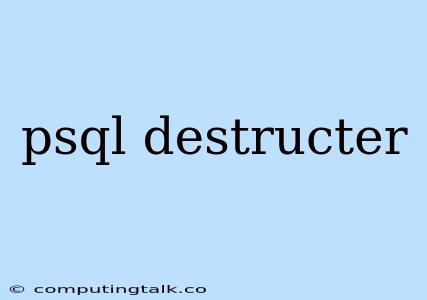Understanding and Utilizing psql Destructors
In the realm of PostgreSQL, database management relies on intricate mechanisms to ensure data integrity and efficiency. Among these mechanisms, psql destructors play a vital role, acting as cleanup agents that gracefully dismantle objects and resources upon the termination of a database session.
What are psql Destructors?
psql destructors are special functions within PostgreSQL that are automatically invoked when a psql session ends. They are specifically designed to handle the release of resources or the cleanup of temporary objects that were created during the session.
Imagine a scenario where you are working with a large dataset and have created temporary tables for analysis. Upon completing your analysis, you would want these temporary tables to be removed to avoid unnecessary storage usage. This is where psql destructors come into play.
How do psql Destructors Work?
The concept of psql destructors is closely tied to the ON COMMIT clause. When you define a function with the ON COMMIT clause, you are essentially instructing PostgreSQL to execute this function whenever a transaction is committed or rolled back. This provides an opportunity to perform actions that are related to the session's lifecycle.
Here's a breakdown of how they function:
- Function Creation: You define a function using the
CREATE FUNCTIONstatement and include theON COMMITclause. This clause specifies that the function should be executed when a transaction is committed. - Session Termination: When your psql session ends, either due to a
\qcommand or a connection closure, a transaction is implicitly committed. - Destructor Execution: The psql destructor function, defined with
ON COMMIT, is automatically executed as part of this transaction commit process.
Common Use Cases for psql Destructors
psql destructors are highly versatile and have various practical applications in database management. Let's explore some common use cases:
- Cleaning up Temporary Objects: As mentioned earlier, destructors can be used to remove temporary tables, indexes, or other objects that are no longer needed after the session ends.
- Releasing Locks: In some situations, you might need to hold locks on certain database objects during your session. Destructors can be used to release these locks automatically upon session closure, preventing potential lock contention.
- Performing Cleanup Tasks: You can define functions to perform other cleanup tasks, like removing temporary files, resetting counters, or updating status flags within your database.
- Managing Resources: Destructors can be used to manage resources, such as connections to external systems or network resources, by ensuring they are closed properly upon session termination.
Examples of psql Destructors
Here are some practical examples of how to create psql destructors in PostgreSQL:
Example 1: Removing a Temporary Table
CREATE FUNCTION cleanup_temp_table() RETURNS VOID AS $
BEGIN
DROP TABLE IF EXISTS temp_data;
END;
$ LANGUAGE plpgsql ON COMMIT DROP;
-- Within your psql session:
CREATE TEMP TABLE temp_data AS SELECT * FROM my_table;
-- ... perform analysis using temp_data ...
-- Session ends - destructor is executed, removing temp_data
Example 2: Releasing a Lock
CREATE FUNCTION release_lock() RETURNS VOID AS $
BEGIN
PERFORM pg_advisory_unlock(12345);
END;
$ LANGUAGE plpgsql ON COMMIT DROP;
-- Within your psql session:
PERFORM pg_advisory_lock(12345);
-- ... perform actions requiring the lock ...
-- Session ends - destructor is executed, releasing the lock
Advantages and Considerations
psql destructors offer a powerful and efficient way to manage resources and cleanup during your database sessions.
Advantages:
- Automatic Execution: They are automatically executed upon session termination, ensuring a consistent cleanup process.
- Resource Management: Help control resource usage by releasing locks, closing connections, and deleting temporary objects.
- Improved Database Integrity: Prevent accidental data corruption or inconsistencies by removing unnecessary temporary objects.
Considerations:
- Side Effects: Ensure your destructor functions do not have unintended side effects.
- Performance Impact: While destructors are designed to be efficient, they can still add a small overhead to your session termination.
- Error Handling: Consider implementing error handling in your destructor functions to prevent unexpected failures.
Conclusion
psql destructors are an invaluable tool for managing resources and maintaining database integrity within PostgreSQL. By leveraging the ON COMMIT clause, you can create functions that automatically execute at the end of your sessions, ensuring a clean and efficient database environment. Understanding and utilizing these destructors allows for better resource management, reduced potential for issues, and a more streamlined workflow.
